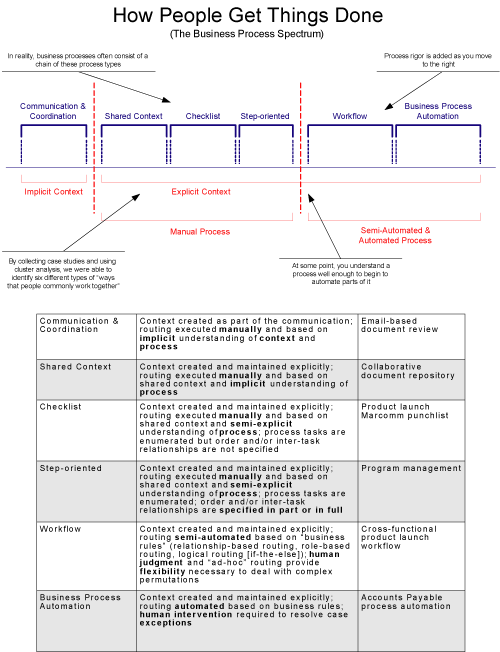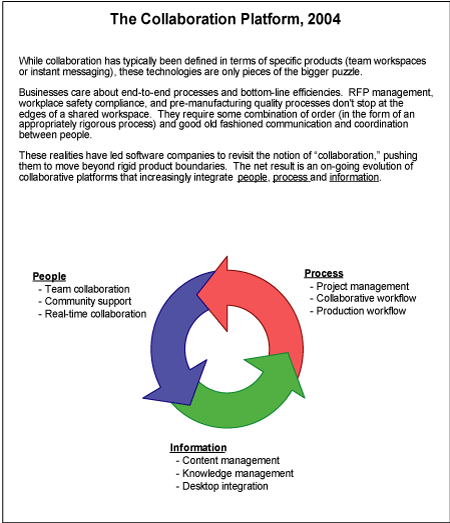April 2004
Content Management and collaboration have always been closely related. Before the term content management was taken over by the early web content management vendors in the mid-to-late 90s, when you asked companies what technologies they were using to manage content, the answer was almost always Lotus Notes or Microsoft Exchange. Today, collaboration is one of the capabilities many ECM vendors promote as part of their broader offerings. But there are other segments of the enterprise software market that also believe that collaboration functionality is key.
This month contributor Jared Spataro, who researched collaboration and content management when he was at the MIT Sloan School and working with us at the Gilbane Report, presents an argument that collaboration is more important than ever. Based on a combination of looking at how people in enterprises get things done, how the working environment has changed, and how the recognition of the importance of collaboration has increased, Jared argues that it is in fact “the next big” thing in enterprise software. Jared bolsters his argument by identifying a list of vendors from other segments of the enterprise software market that provide collaboration functionality. Is collaboration the next big thing? After you read Jared’s article let us know what you think.
Frank Gilbane
Download a complete version of this issue that includes industry news and additional information (PDF)
Yes, collaboration is the Next Big Thing in enterprise software. Want to know why? Read on.
Market dynamics have created the right conditions for collaboration software to take off. Firms get it. Individuals get it. And software vendors get it. That combination is creating a vibrant marketplace as companies try and realize the productivity gains from collaboration, and vendors try and capitalize on the emerging wave of investment.
Business is (nothing more or less than) collaboration
Firms drive performance by managing business processes. Successful businesses identify key processes, tightly manage execution, and invest in continuous improvement. It’s a formula that works.
But the wildcard in the game are People.
People run businesses. And in reality, business process is nothing more or less than collaboration between people. Specific technologies (like Enterprise Resource Planning (ERP) systems, Enterprise Content Management (ECM) solutions, or Business Process Management (BPM) platforms) play a role in managing the information flows in a company. But all the systems and all the processes in the world pivot around people.
That fact intrigued me. And working with various colleagues at MIT—and later at Open Text—I set out to create a framework for understanding how people work with each other and get things done in today’s businesses. A summary of a portion of that work is shown in Figure 1. There’s a lot there. But two points are worth emphasizing:
- Business is collaboration
People generally talk about collaboration in a limited sense; but in a very real way, business is nothing more or less than people collaborating to get things done. - Improving collaboration means improving performance
Real improvements in collaboration translate into real improvements in performance. When people can collaborate to more efficiently process loans, manage clinical trials, and handle customer care requests, the results go straight to the bottom line.
Figure 1. How People Get Things Done
Firms are recognizing the need for better ways to collaborate
Firms are recognizing the need for better ways to collaborate. And they should be. Several important forces have created the conditions that are making investments in collaboration a top priority.
- The next wave of productivity: People + Process + Information
Back-office infrastructure projects are far from dead. But companies are realizing that the next big wave of enterprise productivity will come by unlocking the front office potential in people + process + information. Leading companies in every industry are critically evaluating what makes their business tick. In the most forward thinking companies I’ve worked with, for instance, managers are identifying key people-based business processes and then using collaboration software to reduce cycle times, improve quality, and manage risk. - Firms are increasingly distributed
Mergers, acquisitions, and distributed global operations mean that processes now span more functional units, time zones, and borders than ever before. As one executive recently explained to me, “We’ve connected the networks. Now we want to connect the people.” - IT organizations are recognizing the need to get a handle on collaboration
The diffusion of instant messaging and web conferencing demonstrated the grass-roots demand for collaboration tools. Often skipping the IT department entirely, millions of workers relied on external services to meet demands for connecting with others. Today, IT organizations are recognizing the need to get a handle on collaboration. - IT Governance is driving spending decisions
The word on the street today in IT shops is “Governance,” a trend that involves a rationalization of the IT infrastructure, a selection of strategic software partners, and a coherent strategy for a technology fabric to control costs and prepare for growth. In the context of IT Governance, businesses are looking for strategic software partners to support collaboration investments. - Key organizational groups have started to “get it”
It’s one thing for HR or IT to talk about collaboration. It’s another thing entirely when operations, finance, and line-of-business managers start to demand it. Increasingly, key organizational units in the companies I have worked with are taking the lead in calling for better tools and technologies to support the collaborative aspects of their work.
Individuals are recognizing the need for better ways to collaborate
Individuals are recognizing the need for better ways to collaborate. In recent research involving end-users in more than 100 companies across 30 industries, I identified three trends driving this evolving demand. Based on a careful analysis of key messages in both the quantitative (survey) and qualitative (interview) data, I also projected the evolution of the technologies to meet these demands.
Three trends driving evolving demand
- Team workspaces are achieving critical mass
- Web conferencing and instant messaging are conditioning users to use and expect on-demand, in-context communication
- Experience with these basic collaboration technologies is influencing and accelerating user demands for new innovations
The evolution of collaboration technologies
- Tight integration of content platforms with both real-time and asynchronous collaboration tools
- Targeted interfaces to deliver collaborative capabilities when and where they are needed
- Graceful escalation of interactions from instant messaging to rich interactive experiences
Universal access to innovations in collaboration has primed the market and is fueling increasing demands for continuous improvement.
Software vendors are recognizing the strategic importance of collaboration
Software vendors are recognizing the strategic importance of collaboration. The name of the game in enterprise software is “network externality,” a concept that economists use to explain how the value of certain goods varies with the number of users. In enterprise software, the value of a technology increases significantly with the number of people using it. Microsoft Office is the prototypical example. As more people standardized on Office, its value increased, creating a virtuous cycle that eventually lead to total market domination. Vendors have recognized that the collaborative platform will be the next big network externality in the industry. Many have already started to actively pursue strategies to ride the wave. These vendors operate from established power bases and are leveraging their strengths to compete.
It is a busy space. The competitive field is best understood in terms of six “centers of gravity:”
(1) Microsoft
Power base: the operating system and Office suite
Top-tier competitors: Operating System, Office Suite, SharePoint Portal Server
Microsoft’s investment in collaboration is designed to extend market power in its OS and Office franchises.
(2) Enterprise Content Management (ECM) Vendors
Power base: document/content management Platforms
Top-tier competitors: EMC Documentum, Hummingbird, FileNet, Open Text
Companies to watch: Interwoven, Vignette
Enterprise Content Management vendors see collaboration as the primary vehicle for enterprise deployments.
(3) Portal & App Server Vendors
Power base : app server
Top-tier competitors: IBM, Oracle, BEA
Companies to watch: Plumtree, Vignette (Epicentric)
App Server vendors are using the portal concept as a unifying concept to promote products and services from their respective power bases. Pure-play portal vendors are reacting to pressure to increasingly incorporate collaborative features in their offerings.
(4) ERP Vendors
Power base: ERP platform
Top-tier competitors: SAP, PeopleSoft
Looking for high-growth opportunities, SAP and PeopleSoft are interested in Collaboration, KM, and Content Management.
(5) Network Infrastructure, Telecomm & Web Conferencing Vendors
Power base: network infrastructure
Top-tier competitors: Cisco, Nortel
Companies to watch: WebEX, Raindance
Network infrastructure, telecomm and web conferencing vendors have been investing heavily in the audio/video side of collaboration.
(6) Other Vendors
Power base: Varied
Top-tier competitors: Groove, Tenix, Convoq, Glance
These innovative companies are rapidly developing tools and technologies that have the potential to change the game for the larger enterprise market.
Figure 2. The Collaboration Platform
Deep pockets and market power will make the competition for dominance in the collaboration market a fierce battle.
Market forces will make collaboration the segment to watch
Firms get it. Economic dynamics have created the right conditions for companies to understand the broader implications of improved, process-based collaboration.
Individuals get it. Technology dynamics have created the right conditions for individuals to understand the potential of collaborative technologies.
And vendors get. Competitive dynamics have created the right conditions for vendors to realize the strategic importance of the emerging collaboration platform.
That combination is creating a vibrant marketplace and will transform collaboration into the Next Big Thing for enterprise software.
Jared Spataro
[Disclosure: Jared’s research convinced him to work in the field, and he joined Open Text.]




